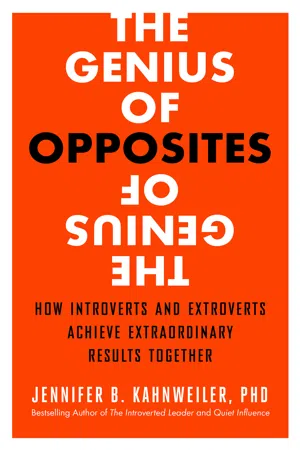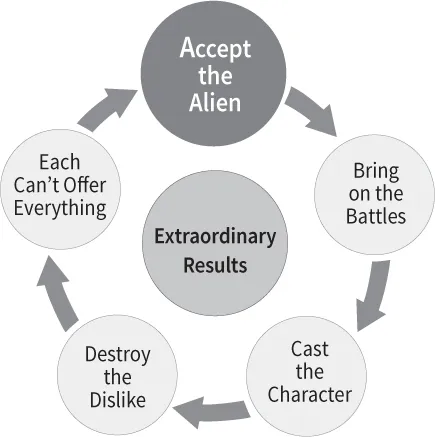![]() Part II
Part II
The Steps![]()
Chapter 3
Accept the Alien
“Accept that your partner is a pain in the ass. Accept that you are a pain in the ass, so the two of you are made for each other. Accept that what makes you furious about your partner is wrapped up with what excites you. What you most love and what drives you crazy is the same thing. Just on a bad hair day.”6
—Joshua Wolf Shenk, author of Powers of Two
Anthony Morris and Errol la Grange run a growing online training organization in Melbourne, Australia. These opposites’ creative ideas explode like popcorn.
Anthony is a thoughtful and mild-mannered introvert who sent me fully thought-out responses to my questions about their partnership. Errol is a smiling extrovert who shows up in daily Facebook posts, meeting people around the world. He thrives on going to coffee shops and chatting with just about anyone. Their complementary differences showed up when I met them both for the first time. Anthony wore what he called his “good ole brown pull-on shoes” purchased from a local shoe store, and Errol stood out in his turquoise cowboy boots from San Francisco, making for a great conversation starter.
Both partners thrive on innovation and keep growing their global business, taking advantage of technology to find the best way to deliver learning solutions to their clients. They are leaders in the Massive Online Open Classroom (MOOC) movement, leading global initiatives in this new emerging field.
Their deep mutual affection and respect spring from having built a business and friendship together over the past ten years. Anthony smiles knowingly at his partner, and Errol pauses to allow Anthony space to interject his thoughts.
Errol also describes how talking through conflict deepens their strong partnership. “We often have different perspectives on strategy. We talk it through and usually come to better solutions together than alone. We understand that conflict holds the key to opportunity at its core. There is also a lot of intuitive guidance in how we relate.” They “can often sense what the other is feeling,” says Errol. There are times when one of them feels particularly strongly and the other goes along with the idea.
They disagree, but there is no doubt that these two get past the friction of their natural disappointments. They accept the alien and that helps them get things done.
Why Accepting the Alien Matters
Communication is such a loaded word. The dictionary definition is vanilla: the exchange of information between two people. But we all know that exchange can carry misunderstanding, friction, and annoyance. When introvert/extrovert partnerships are rocky, the conflict usually reflects a breakdown in this exchange. Sometimes the person sitting across from you with all those weird interpretations of what the client said can feel as alien to you as something that crawled out of a spaceship. When that happens, stifle the impulse to flee or grab a weapon. Genius beckons.
In describing those inevitable times, introvert/extrovert partners will say, “It is too much work to figure him/her out.” Or they will avoid their opposite, leading to a pile of unattended hurts, disconnects, and confusion that are difficult to come back from.
Successful introvert/extrovert opposites make the decision to accept each other and not let communication differences impede their ultimate outcome: to make a great product, deliver the best service possible, and achieve breakthroughs.
There are two key reasons why accepting the alien matters: it builds empathy and makes the partnership stronger.
Acceptance Builds Empathy in Each Partner
Maybe you have participated in a “blind walk” exercise designed to awaken understanding for the visually impaired. I recall being led blindfolded down a wooded trail. I relied on my partner John’s every step, afraid I would stumble and fall without his guidance. I also noticed how my other senses kicked in—smell, hearing, and touch ready to help guide me along.
After that experience, I had a glimmer of awareness of what it might be like to experience blindness. I also realized the opportunities to awaken other parts of my brain even though I could never truly know what it is like to fully inhabit a blind person’s experience.
It is the same with introvert/extrovert relationships. When we work with our opposite, we have great opportunities to appreciate another view, even though we don’t understand everything they live through. But by stepping into their world, we also awaken parts of ourselves that have lain dormant, allowing us to throttle up our performance. Suddenly, the person doesn’t seem like an alien after all.
The Partnership Becomes Stronger
Through the process of working closely together, opposites can become a stronger unit over time. When they face successes and failures, both have grown together, not just individually. An exponential power forms to help them meet the next challenge, the next opportunity.
When we grapple with tough problems and decisions together, not only do we learn more about how to move forward as a team, but also more opportunities to be creative emerge.
In the entertainment business, rejection and disappointments are as daily as coffee and bagels. Referring to his 1971 musical Follies collaborator James Goldman, Stephen Sondheim observed, “One of the advantages of having a collaborator is that you are never slammed in the face alone. You are always in the boat with somebody.”7
Good communication with your partner allows you to collaborate—to grab the best from both of you. Anthony, mentioned earlier, is a former musician and likened his friendship with Errol as a kind of harmony, an arrangement of different notes that come together to create something that cannot be achieved by one note. “One note would be unison, not harmony,” he said.
Another creative pair, composer John Williams and filmmaker Steven Spielberg, have been collaborating on Oscar-winning films like E.T. and Saving Private Ryan for more than four decades. In a 2014 interview, they appear very at ease with each other, and their conversation flows as they describe working together.8
Williams appears the more introverted of the two; he speaks in measured tones, while the extroverted Spielberg takes up more airtime to make his points. They each point to the ease of collaboration as time goes on. “As I get better, I know how to use him better,” Spielberg explains. As is true for Errol and Anthony, John Williams describes the dynamic of fun in their partnership. He can tell by Spielberg’s eyes and facial expression whether he “has it” or not. “Even when I don’t have it, we are having fun anyway.”
Instead of getting irritated, partners in all fields learn to read each other’s nonverbal signals over time just like Spielberg and Williams do. These cues become gateways to gain deeper understanding of the alien’s point of view, allowing him or her to move back and forth with relative ease.
How Accepting the Alien Can Break Down
Not Realizing That Your Strengths Are My Weaknesses
Not stopping to consider differences in personality can cause problems. My younger daughter, Jessie Kahnweiler, is an LA-based filmmaker who has had the opportunity to work with many introverted pros on her film crews. On a complex video shoot she hired Liam, an experienced and highly regarded introverted director of photography. As they were scoping out the shots, extroverted Jessie spilled over with ideas and could barely contain her enthusiasm. She sensed that Liam was not sharing the excitement she had hoped he would. Jessie would text him ideas for locations, and he would respond with short, terse replies.
On the day of the shoot, Liam appeared with a large notebook of carefully thought-out shots that incorporated many of the ideas she had been pitching him. Jessie realized that Liam was listening and engaging with her all along; just quietly and in his space. He actually had a deep love and understanding of the project but was approaching it in his internally focused, methodical way. “Liam’s strengths were my weaknesses,” Jessie shared. “He is a planner and needed time to sort things out in his head. That is exactly what was needed. I think introverts have a confidence because they trust their minds so much. They spend a great deal of time alone thinking about things and processing. He is not going to change and neither am I. God knows, we only need one of me!”
It happens; even the most accepting partners lose their patience at times. The culprit behind it? Usually stress.
Stress can be a good thing; it can energize us and get us moving. However, we can react in ways that are not productive for the partnership or ultimately ourselves. Here are a few ways stress undermines accepting the alien in an introvert/extrovert pair.
Introverts Shut Down, Extroverts Talk More
When stress happens, we often go into overdrive on our personality characteristics. Introverts shut down and extroverts talk more. This creates tension as the introvert is thinking, Won’t she ever shut up? and the extrovert is thinking, What is going on in her head?!
Errol and Anthony, the Australian partners, had one of their few big disagreements over a request from Errol to add a color to a design that Anthony and his team had been working on for a while. Introverted Anthony responded by shutting down and actually not speaking to Errol for a day. “I was pretty riled by it all. Nothing else was said for the rest of the workday.” They clarified that what Errol had meant was that he wanted to see the color in the design, not that it actually had to change. They restarted their communication and all was good again. When opposites don’t do that, however, these misfires keep happening, leading to potentially irreparable explosions.
Outside Stress Can Also Take a Toll
The 2008 recession was a turning point for Han, an introverted Korean consultant, and his extroverted Chinese partner, Mei. They co-owned a risk management/consulting firm and had been doing very well as a partnership and company until the recession.
“Mei was a natural saleswoman, but unfortunately made promises that we couldn’t deliver on. Her enthusiasm and strong client relationships were assets and overrode my concerns. That is, until the consulting gigs started dropping. We were not delivering on our promises, and our service started to slip. This was unacceptable to me. Mei was not interested in scaling back the business, and we parted ways. It was definitely the stress of the recession that made the difference. I think we would still be together if our values had not been tested in that way.”
Han had just purchased a new house and had mortgage payments on his mind. Mei was the sole breadwinner for her family and also felt a lot riding on her shoulders. These economic pressures had a significant impact on the duo. In other cases, problems with children, spouses, parents, and friends are all factors that can significantly complicate the communication flow between opposites.
These outside stressful events like a department move or a change in managers can bring out our fears and lower our tolerance levels. Introverts become more internally focused. Extroverts go into high-energy mode. Clashes occur more frequently. And these moments also provide the true test of whether a partnership will survive.
Several years ago, my twenty-something daughter, Lindsey, an e...



